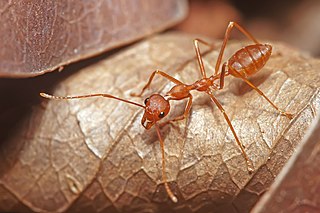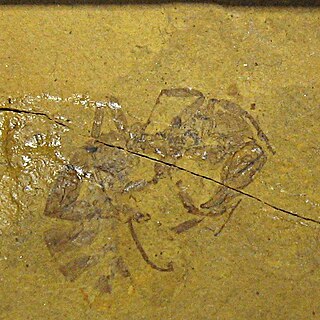
Ants are eusocial insects of the family Formicidae and, along with the related wasps and bees, belong to the order Hymenoptera. Ants evolved from vespoid wasp ancestors in the Cretaceous period. More than 13,800 of an estimated total of 22,000 species have been classified. They are easily identified by their geniculate (elbowed) antennae and the distinctive node-like structure that forms their slender waists.

Fire ants are several species of ants in the genus Solenopsis, which includes over 200 species. Solenopsis are stinging ants, and most of their common names reflect this, for example, ginger ants and tropical fire ants. Many of the names shared by this genus are often used interchangeably to refer to other species of ant, such as the term red ant, mostly because of their similar coloration despite not being in the genus Solenopsis. Both Myrmica rubra and Pogonomyrmex barbatus are common examples of non-Solenopsis ants being termed red ants.

Formica is a genus of ants of the family Formicidae, commonly known as wood ants, mound ants, thatching ants, and field ants. Formica is the type genus of the Formicidae, and of the subfamily Formicinae. The type species of genus Formica is the European red wood ant Formica rufa. Ants of this genus tend to be between 4 and 8 mm long. Ants belonging to the Formica genus possess a single knob or bump located between their thorax and abdomen. These ants primarily feed on honeydew, a sugary liquid produced by aphids. Interestingly, Formica ants appear to take on a shepherding role with smaller aphids, relocating them to different parts of plants to ensure a continuous food source for the aphids. By doing so, the ants can establish a relatively sustainable honeydew supply for both themselves and their colony.

An ant colony is a population of a single ant species able to maintain its complete lifecycle. Ant colonies are eusocial, communal, and efficiently organized and are very much like those found in other social Hymenoptera, though the various groups of these developed sociality independently through convergent evolution. The typical colony consists of one or more egg-laying queens, numerous sterile females and, seasonally, many winged sexual males and females. In order to establish new colonies, ants undertake flights that occur at species-characteristic times of the day. Swarms of the winged sexuals depart the nest in search of other nests. The males die shortly thereafter, along with most of the females. A small percentage of the females survive to initiate new nests.

Myrmecia is a genus of ants first established by Danish zoologist Johan Christian Fabricius in 1804. The genus is a member of the subfamily Myrmeciinae of the family Formicidae. Myrmecia is a large genus of ants, comprising at least 93 species that are found throughout Australia and its coastal islands, while a single species is only known from New Caledonia. One species has been introduced out of its natural distribution and was found in New Zealand in 1940, but the ant was last seen in 1981. These ants are commonly known as bull ants, bulldog ants or jack jumper ants, and are also associated with many other common names. They are characterized by their extreme aggressiveness, ferocity, and painful stings. Some species are known for the jumping behavior they exhibit when agitated.

Myrmicinae is a subfamily of ants, with about 140 extant genera; their distribution is cosmopolitan. The pupae lack cocoons. Some species retain a functional sting. The petioles of Myrmicinae consist of two nodes. The nests are permanent and in soil, rotting wood, under stones, or in trees.

Weaver ants or green ants are eusocial insects of the family Formicidae. Weaver ants live in trees and are known for their unique nest building behaviour where workers construct nests by weaving together leaves using larval silk. Colonies can be extremely large consisting of more than a hundred nests spanning numerous trees and containing more than half a million workers. Like many other ant species, weaver ants prey on small insects and supplement their diet with carbohydrate-rich honeydew excreted by small insects (Hemiptera). Weaver ant workers exhibit a clear bimodal size distribution, with almost no overlap between the size of the minor and major workers. The major workers are approximately 8–10 mm (0.31–0.39 in) in length and the minors approximately half the length of the majors. Major workers forage, defend, maintain, and expand the colony whereas minor workers tend to stay within the nests where they care for the brood and 'milk' scale insects in or close to the nests.

The name army ant (or legionary ant or marabunta) is applied to over 200 ant species in different lineages. Because of their aggressive predatory foraging groups, known as "raids", a huge number of ants forage simultaneously over a limited area.

Dolichoderinae is a subfamily of ants, which includes species such as the Argentine ant, the erratic ant, the odorous house ant, and the cone ant. The subfamily presents a great diversity of species throughout the world, distributed in different biogeographic realms, from the Palearctic, Nearctic, Afrotropical region and Malaysia, to the Middle East, Australian, and Neotropical regions.

The Myrmecophagidae are a family of anteaters, the name being derived from the Ancient Greek words for 'ant' and 'eat'. Two genera and three species are in the family, consisting of the giant anteater, and the tamanduas. The fossil Eurotamandua from the Messel Pit in Germany may be an early anteater, but its status is currently debated.

Ant mimicry or myrmecomorphy is mimicry of ants by other organisms. Ants are abundant all over the world, and potential predators that rely on vision to identify their prey, such as birds and wasps, normally avoid them, because they are either unpalatable or aggressive. Spiders are the most common ant mimics. Additionally, some arthropods mimic ants to escape predation, while others mimic ants anatomically and behaviourally to hunt ants in aggressive mimicry. Ant mimicry has existed almost as long as ants themselves; the earliest ant mimics in the fossil record appear in the mid Cretaceous alongside the earliest ants. Indeed one of the earliest, Burmomyrma, was initially classified as an ant.

Huttoniidae is a family of ecribellate araneomorph spiders containing a single genus, Huttonia, itself containing a single described species, Huttonia palpimanoides. It is known only from New Zealand.

Iridomyrmex is a genus of ants called rainbow ants first described by Austrian entomologist Gustav Mayr in 1862. He placed the genus in the subfamily Dolichoderinae of the family Formicidae. It has 79 described species and five fossil species. Most of these ants are native to Australia; others are found in Asia and Oceania, and they have been introduced to Brazil, New Zealand, and the United Arab Emirates. Fossil species are known from China, France, and the United States.

A queen ant is an adult, reproducing female ant in an ant colony; generally she will be the mother and leader of all the other ants in that colony. Some female ants, such as the Cataglyphis, do not need to mate to produce offspring, reproducing through asexual parthenogenesis or cloning, and all of those offspring will be female. Others, like those in the genus Crematogaster, mate in a nuptial flight. Queen offspring ants develop from larvae specially fed in order to become sexually mature among most species. Depending on the species, there can be either a single mother queen, or potentially hundreds of fertile queens in some species. A queen of Lasius niger was held in captivity by German entomologist Hermann Appel for 283⁄4 years; also a Pogonomyrmex owyheei has maximum estimated longevity of 30 years in the field.

Aphaenogaster is a genus of myrmicine ants. About 200 species have been described, including 18 fossil species. They occur worldwide except in South America south of Colombia, sub-Saharan Africa, and Antarctica.

Macabeemyrma is an extinct genus of bulldog ants in the subfamily Myrmeciinae containing the single species Macabeemyrma ovata, described in 2006 from Ypresian stage deposits of British Columbia, Canada. Only a single specimen is known; a holotype queen found preserved as a compression fossil. The specimen had no wings and small portions of its legs and eyes were faintly preserved. It was a large ant, reaching 25 millimetres (0.98 in) in length. This ants' behaviour would have been similar to that of extant Myrmeciinae ants, such as foraging singly in search for arthropod prey and nesting in soil or in trees. Macabeemyrma shows similarities to extinct ants in the genus Ypresiomyrma, and to the living Nothomyrmecia macrops, but has not been conclusively assigned to any tribe, instead generally regarded as incertae sedis within Myrmeciinae. However, the sole specimen lacks definitive traits, and its classification in Myrmeciinae, and even its identity as an ant, has been challenged.

Myrmeciites is an extinct form genus of bulldog ants in the subfamily Myrmeciinae of the family Formicidae, which contains three described species and two fossils not placed beyond the genus level. Described in 2006 from Ypresian stage deposits, all three of the described species and one unplaced fossil are from British Columbia, Canada, while the second unplaced fossil is from Washington State, USA. These ants were large, with the largest specimens collected reaching 3 centimetres (1.2 in). The behaviour of these ants would have been similar to extant Myrmeciinae ants, such as solitary foraging, nesting either in the soil or trees, and leaving no pheromone trail to food sources. Due to the poor preservation of these ants, their phylogenetic position among Myrmeciinae is unclear, and no type species has been designated. These ants are classified as incertae sedis in Myrmeciinae, but some writers have classified it as incertae sedis within the insect order Hymenoptera. This reclassification, however, has not been accepted; instead, Myrmeciites remains in Myrmeciinae.

Tatuidris, or armadillo ant, is a rare genus of ants consisting of a single species, Tatuidris tatusia. The ants are small in size and inhabit the leaf litter of Neotropical forests in Central and South America, from Mexico to Brazil. Workers are ferruginous-colored to dark red and present a distinctive morphology, consisting of a shield-like head with a broad vertex, ventrally-turned heavy mandibles which do not overlap at full closure, and unique among ants – an antenna socket apparatus sitting upside-down. Little is known about the biology of the ants, but they are likely nocturnal and specialist predators.

Nylanderia is a large genus of ants in the subfamily Formicinae. The genus has a nearly cosmopolitan distribution with species inhabiting a wide array of habitats in almost all geographic regions. Nylanderia, currently containing over 110 species, is an ecologically important genus, with some species reported as being invasive. The ants are small to medium in size and range in color from pale yellow to black.


















